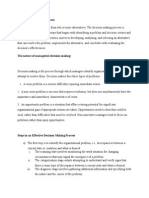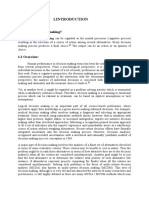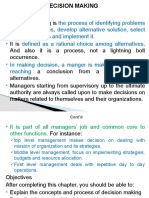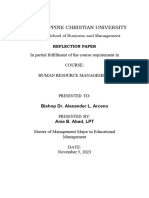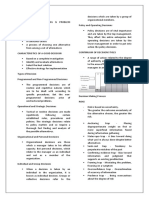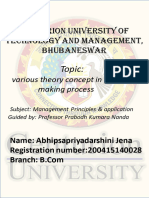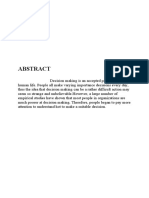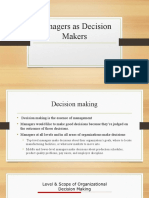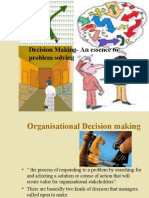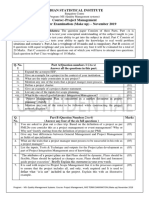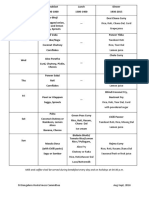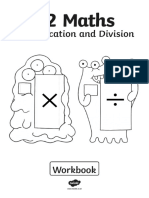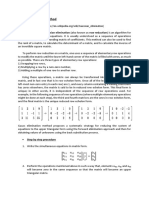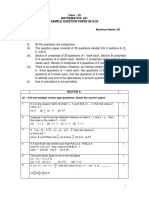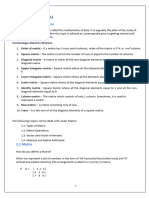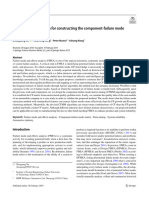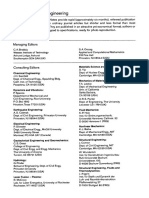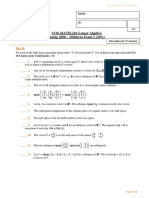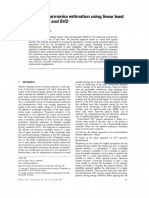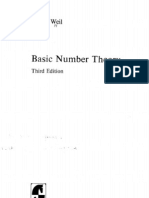0 ratings0% found this document useful (0 votes)
31 views72 pagesMCDM Introduction
Uploaded by
Akhilesh MandalCopyright
© © All Rights Reserved
We take content rights seriously. If you suspect this is your content, claim it here.
Available Formats
Download as PDF, TXT or read online on Scribd
0 ratings0% found this document useful (0 votes)
31 views72 pagesMCDM Introduction
Uploaded by
Akhilesh MandalCopyright
© © All Rights Reserved
We take content rights seriously. If you suspect this is your content, claim it here.
Available Formats
Download as PDF, TXT or read online on Scribd
You are on page 1/ 72
Decision Making Process
Decision making is the cognitive process leading to the
selection of a course of action among alternatives.
Decision Making Process
Decision making is the cognitive process leading to the
selection of a course of action among alternatives.
Every decision-making process produces a final choice
(sometimes called a solution).
Decision Making Process
Decision making is the cognitive process leading to the
selection of a course of action among alternatives.
Every decision-making process produces a final choice
(sometimes called a solution).
In general, a decision process begins when we need to find a
solution but we do not know what and when a solution is
accepted by decision makers.
Decision Making Process
Decision making is the cognitive process leading to the
selection of a course of action among alternatives.
Every decision-making process produces a final choice
(sometimes called a solution).
In general, a decision process begins when we need to find a
solution but we do not know what and when a solution is
accepted by decision makers.
Decision making can be also seen as a reasoning process,
which can be rational or irrational, and can be based on
explicit assumptions or tacit assumptions
Decision Making Process
Decision making is the cognitive process leading to the
selection of a course of action among alternatives.
Every decision-making process produces a final choice
(sometimes called a solution).
In general, a decision process begins when we need to find a
solution but we do not know what and when a solution is
accepted by decision makers.
Decision making can be also seen as a reasoning process,
which can be rational or irrational, and can be based on
explicit assumptions or tacit assumptions
A systematic decision-making process proposed by Simon
(1977) involves three phases: Intelligence, Design, and Choice.
Decision Making Process
Decision making is the cognitive process leading to the
selection of a course of action among alternatives.
Every decision-making process produces a final choice
(sometimes called a solution).
In general, a decision process begins when we need to find a
solution but we do not know what and when a solution is
accepted by decision makers.
Decision making can be also seen as a reasoning process,
which can be rational or irrational, and can be based on
explicit assumptions or tacit assumptions
A systematic decision-making process proposed by Simon
(1977) involves three phases: Intelligence, Design, and Choice.
A fourth phase, Implementation added later.
Decision Making Process...
Steps in Making Decision
Different decision-making problems may also require more details
or sub-phases and support techniques in one or more phases.
Step 1: Identify decision problems-To identify a decision
problem includes good understanding on managerial
assumptions, organisational boundaries, and any related initial
and desired conditions.
Steps in Making Decision
Different decision-making problems may also require more details
or sub-phases and support techniques in one or more phases.
Step 1: Identify decision problems-To identify a decision
problem includes good understanding on managerial
assumptions, organisational boundaries, and any related initial
and desired conditions.
Step 2: Analyse requirements-Requirements are conditions in
which any acceptable solution to the problem must meet. In a
mathematical form, these requirements are the constraints
describing the set of the feasible solutions of the decision
problem.
Steps in Making Decision
Different decision-making problems may also require more details
or sub-phases and support techniques in one or more phases.
Step 1: Identify decision problems-To identify a decision
problem includes good understanding on managerial
assumptions, organisational boundaries, and any related initial
and desired conditions.
Step 2: Analyse requirements-Requirements are conditions in
which any acceptable solution to the problem must meet. In a
mathematical form, these requirements are the constraints
describing the set of the feasible solutions of the decision
problem.
Step 3: Establish objectives and goals- This step identifies the
important objectives of the decision problem and their goals.
Steps in Making Decision
Different decision-making problems may also require more details
or sub-phases and support techniques in one or more phases.
Step 1: Identify decision problems-To identify a decision
problem includes good understanding on managerial
assumptions, organisational boundaries, and any related initial
and desired conditions.
Step 2: Analyse requirements-Requirements are conditions in
which any acceptable solution to the problem must meet. In a
mathematical form, these requirements are the constraints
describing the set of the feasible solutions of the decision
problem.
Step 3: Establish objectives and goals- This step identifies the
important objectives of the decision problem and their goals.
Step 4: Generate alternatives-Objectives obtained will be used
to help generating alternatives. But any alternative must meet
the requirements.
Steps...
Step 5: Determine criteria if needed- To choose the best
alternative, we need to evaluate all alternatives against
objectives.
Steps...
Step 5: Determine criteria if needed- To choose the best
alternative, we need to evaluate all alternatives against
objectives.
Step 6: Select a decision-making method or tool- In general,
there are always several methods or tools available for solving
a decision problem. The selection of an appropriate method or
tool depends on the concrete decision problem and the
preference of decision makers.
Steps...
Step 5: Determine criteria if needed- To choose the best
alternative, we need to evaluate all alternatives against
objectives.
Step 6: Select a decision-making method or tool- In general,
there are always several methods or tools available for solving
a decision problem. The selection of an appropriate method or
tool depends on the concrete decision problem and the
preference of decision makers.
Step 7: Evaluate alternatives against criteria- The choice
phase of decision making begins with this step. A tentative
decision will be made in this step through the evaluation of
the alternatives against the objectives by using the determined
criteria supported by the selected method or tool.
Steps...
Step 8: Validate solutions against problem statements-If the
tentatively chosen alternative has no significant adverse
consequences, the choice is made. However, the alternatives
selected by the applied decision-making method or tool have
always to be validated against the requirements and goals of
the decision problem.
Steps...
Step 8: Validate solutions against problem statements-If the
tentatively chosen alternative has no significant adverse
consequences, the choice is made. However, the alternatives
selected by the applied decision-making method or tool have
always to be validated against the requirements and goals of
the decision problem.
Step 9: Implement the problem- This step is to use the
obtained solution to the decision problem.
Multi-criteria Decision Making
Generally, managerial problems are seldom evaluated with a
single or simple goal, like profit maximisation.
Multi-criteria Decision Making
Generally, managerial problems are seldom evaluated with a
single or simple goal, like profit maximisation.
Today’s management systems are much more complex, and
managers want to attain simultaneous goals, in which some of
them conflict.
Multi-criteria Decision Making
Generally, managerial problems are seldom evaluated with a
single or simple goal, like profit maximisation.
Today’s management systems are much more complex, and
managers want to attain simultaneous goals, in which some of
them conflict.
Therefore, it is often necessary to analyse each alternative in
light of its determination of each of several goals.
Multi-criteria Decision Making
Generally, managerial problems are seldom evaluated with a
single or simple goal, like profit maximisation.
Today’s management systems are much more complex, and
managers want to attain simultaneous goals, in which some of
them conflict.
Therefore, it is often necessary to analyse each alternative in
light of its determination of each of several goals.
For a profit-making company, in addition to earning money, it
also wants to develop new products, provide job security to its
employees, and serve the community.
Multi-criteria Decision Making
Generally, managerial problems are seldom evaluated with a
single or simple goal, like profit maximisation.
Today’s management systems are much more complex, and
managers want to attain simultaneous goals, in which some of
them conflict.
Therefore, it is often necessary to analyse each alternative in
light of its determination of each of several goals.
For a profit-making company, in addition to earning money, it
also wants to develop new products, provide job security to its
employees, and serve the community.
Managers want to satisfy the shareholders and, at the same
time, enjoy high salaries and expense accounts; employees
want to increase their take-home pay and benefits.
Multi-criteria Decision Making
Generally, managerial problems are seldom evaluated with a
single or simple goal, like profit maximisation.
Today’s management systems are much more complex, and
managers want to attain simultaneous goals, in which some of
them conflict.
Therefore, it is often necessary to analyse each alternative in
light of its determination of each of several goals.
For a profit-making company, in addition to earning money, it
also wants to develop new products, provide job security to its
employees, and serve the community.
Managers want to satisfy the shareholders and, at the same
time, enjoy high salaries and expense accounts; employees
want to increase their take-home pay and benefits.
When a decision is to be made, say, about an investment
project, some of these goals complement each other while
others conflict.
MCDM
Multi-criteria decision making (MCDM) refers to making
decision in the presence of multiple and conflicting criteria.
MCDM
Multi-criteria decision making (MCDM) refers to making
decision in the presence of multiple and conflicting criteria.
Problems for MCDM may range from our daily life, such as
the purchase of a car.
MCDM
Multi-criteria decision making (MCDM) refers to making
decision in the presence of multiple and conflicting criteria.
Problems for MCDM may range from our daily life, such as
the purchase of a car.
MCDM problems share the following common characteristics:
• Multiple criteria: each problem has multiple criteria, which can be
objectives or attributes.
• Conflicting among criteria: multiple criteria conflict with each other.
• Incommensurable unit: criteria may have different units of measurement.
• Design/selection: solutions to an MCDM problem are either to design the
best alternative(s) or to select the best one among previously specified
finite alternatives.
MCDM
Multi-criteria decision making (MCDM) refers to making
decision in the presence of multiple and conflicting criteria.
Problems for MCDM may range from our daily life, such as
the purchase of a car.
MCDM problems share the following common characteristics:
• Multiple criteria: each problem has multiple criteria, which can be
objectives or attributes.
• Conflicting among criteria: multiple criteria conflict with each other.
• Incommensurable unit: criteria may have different units of measurement.
• Design/selection: solutions to an MCDM problem are either to design the
best alternative(s) or to select the best one among previously specified
finite alternatives.
There are two types of criteria: objectives and attributes.
Therefore, the MCDM problems can be broadly classified into two
categories:
Multi-objective decision making (MODM)
Multi-attribute decision making (MADM)
The main difference between MODM and MADM is that the:
MODM concentrates on continuous decision spaces, primarily
on mathematical programming with several objective
functions, and
The main difference between MODM and MADM is that the:
MODM concentrates on continuous decision spaces, primarily
on mathematical programming with several objective
functions, and
MADM focuses on problems with discrete decision spaces.
Further terminologies:
Criteria are the standard of judgment or rules to test
acceptability. In the MCDM literature, it indicates attributes
and/or objectives.
The main difference between MODM and MADM is that the:
MODM concentrates on continuous decision spaces, primarily
on mathematical programming with several objective
functions, and
MADM focuses on problems with discrete decision spaces.
Further terminologies:
Criteria are the standard of judgment or rules to test
acceptability. In the MCDM literature, it indicates attributes
and/or objectives.
Objectives are the reflections of the desire of decision makers
and indicate the direction in which decision makers want to
work. An MODM problem, as a result, involves the design of
alternatives that optimises or most satisfies the objectives of
decision makers.
The main difference between MODM and MADM is that the:
MODM concentrates on continuous decision spaces, primarily
on mathematical programming with several objective
functions, and
MADM focuses on problems with discrete decision spaces.
Further terminologies:
Criteria are the standard of judgment or rules to test
acceptability. In the MCDM literature, it indicates attributes
and/or objectives.
Objectives are the reflections of the desire of decision makers
and indicate the direction in which decision makers want to
work. An MODM problem, as a result, involves the design of
alternatives that optimises or most satisfies the objectives of
decision makers.
Attributes are the characteristics, qualities, or performance
parameters of alternatives. An MADM problem involves the
selection of the best alternative from a pool of pre-selected
alternatives described in terms of their attributes.
MODM Models
An MODM model considers a vector of decision variables,
objective functions, and constraints.
MODM Models
An MODM model considers a vector of decision variables,
objective functions, and constraints.
Decision makers attempt to maximise (or minimise) the
objective functions.
MODM Models
An MODM model considers a vector of decision variables,
objective functions, and constraints.
Decision makers attempt to maximise (or minimise) the
objective functions.
Since this problem has rarely a unique solution, decision
makers are expected to choose a solution from among the set
of efficient solutions (as alternatives).
MODM problem can be formulated as:
Max f (x),
Subject to x ∈ X = {x ∈ R n : g (x) ≤ b, x ≥ 0}.
where f (x) = (f1 (x), f2 (x), ..., fn (x)) represents n conflicting
objective functions, g (x) = (g1 (x), g2 (x), ..., gm (x)) and
b = (b1 , b2 , ..., bm )T components of m constraints, and x is an
n-vector of decision variables x ∈ R n .
When all functions of an MODM are linear, it is a
multi-objective linear programming (MOLP), which is one of
the most important forms of MODM problems.
When all functions of an MODM are linear, it is a
multi-objective linear programming (MOLP), which is one of
the most important forms of MODM problems.
MOLP are specified by linear objective functions that are to
be maximised (or minimised) subject to a set of linear
constraints.
The standard form of an MOLP problem can be written as follows:
Max f (x) = Cx,
Subject to x ∈ X = {x ∈ R n : Ax ≤ b, x ≥ 0}.
where C is a k × n objective function matrix, A is an m × n
constraint matrix, b is an m-vector of right hand side, and x is an
n-vector of decision variables.
Definition
x ∗ ∈ X is said to be a complete optimal solution, if
fi (x ∗ ) ≥ fi (x), ∀x ∈ X .
Also called ideal or superior solution.
In general, such a complete optimal solution that simultaneously
maximises (or minimises) all objective functions does not always
exist when the objective functions conflict with each other. Thus,
a concept of Pareto-optimal solution is introduced into MOLP.
Definition
x ∗ ∈ X is said to be a complete optimal solution, if
fi (x ∗ ) ≥ fi (x), ∀x ∈ X .
Also called ideal or superior solution.
In general, such a complete optimal solution that simultaneously
maximises (or minimises) all objective functions does not always
exist when the objective functions conflict with each other. Thus,
a concept of Pareto-optimal solution is introduced into MOLP.
Definition
x ∗ ∈ X is said to be a Pareto optimal solution, if and only if there
does not exist another x ∈ X such that fi (x) ≥ fi (x ∗ ), ∀x ∈ X and
fj (x) 6= fj (x ∗ ) for at least one j.
Weighting Method/Wighted sum method/Weighted
average method
The key idea of the weighting method is to transform the multiple
objectives in the MOLP into a weighted single objective functions,
which are described as follows:
Maxwf (x) = ki=1 wi fi (x),
P
subject
Pk to x ∈ X ,
i=1 i = 1.
w
where w = (w1 , w2 , ..., wk ) is a vector of weighting coefficients
assigned to the objective functions.
Weighting Method/Wighted sum method/Weighted
average method
The key idea of the weighting method is to transform the multiple
objectives in the MOLP into a weighted single objective functions,
which are described as follows:
Maxwf (x) = ki=1 wi fi (x),
P
subject
Pk to x ∈ X ,
i=1 i = 1.
w
where w = (w1 , w2 , ..., wk ) is a vector of weighting coefficients
assigned to the objective functions.
Example 1: Let us consider
Maxf (x) = Max(f1 (x), f2 (x)) = (2x1 + x2 , −x1 + 2x2 )
subject to −x1 + 3x2 ≤ 21,
x1 + 3x2 ≤ 27,
4x1 + 3x2 ≤ 45,
3x1 + x2 ≤ 30,
x1 , x2 ≥ 0.
Solution: Taking, w1 = 1, w2 = 0, wf (x) = 2x1 + x2 , the optimal
solution is x1 = 9, x2 = 3.
Optimal objective function values, f1 (x) = 21, f2 (x) = −3.
Taking w1 = 0.5, w2 = 0.5, wf (x) = 1/2(x1 + 3x2 ), the optimal
solution is x1 = 3, x2 = 8.
Optimal objective function values, f1 (x) = 14, f2 (x) = 13. Taking
w1 = 0, w2 = 1, wf (x) = −x1 + 2x2 , the optimal solution is
x1 = 0, x2 = 7.
Optimal objective function values, f1 (x) = 7, f2 (x) = 14.
Case based example
A manufacturing company has six machine types - milling machine,
lathe, grinder, jig saw, drill press, and band saw - whose capacities are to
be devoted to produce three products x1 , x2 , and x3 . Decision makers
have three objectives of maximising profits, quality, and worker
satisfaction. It is assumed that the parameters and the goals of the
MOLP problem are defined precisely in this example as in table below:
Machine Product x1 Product x2 Product x3 Machine
(units) (units) (units) (available hours
Milling machine 12 17 0 1400
Lathe 3 9 8 1000
Grinder 10 13 15 1750
Jig saw 6 0 16 1325
Drill press 0 12 7 900
Band saw 9.5 9.5 4 1075
Profits 50 100 17.5
Quality 92 75 50
Worker Satisfaction 25 100 75
MADM Models
Multi-attribute decision making (MADM) refers to making
preference decision (e.g., evaluation, prioritisation, and
selection) over the available alternatives that are characterised
by multiple, usually conflicting, attributes.
MADM Models
Multi-attribute decision making (MADM) refers to making
preference decision (e.g., evaluation, prioritisation, and
selection) over the available alternatives that are characterised
by multiple, usually conflicting, attributes.
The main feature of MADM is that there are usually a limited
number of predetermined alternatives, which are associated
with a level of the achievement of the attributes.
MADM Models
Multi-attribute decision making (MADM) refers to making
preference decision (e.g., evaluation, prioritisation, and
selection) over the available alternatives that are characterised
by multiple, usually conflicting, attributes.
The main feature of MADM is that there are usually a limited
number of predetermined alternatives, which are associated
with a level of the achievement of the attributes.
Based on the attributes, the final decision is to be made.
Also, the final selection of the alternative is made with the
help of inter- and intra-attribute comparisons.
MADM Models
Multi-attribute decision making (MADM) refers to making
preference decision (e.g., evaluation, prioritisation, and
selection) over the available alternatives that are characterised
by multiple, usually conflicting, attributes.
The main feature of MADM is that there are usually a limited
number of predetermined alternatives, which are associated
with a level of the achievement of the attributes.
Based on the attributes, the final decision is to be made.
Also, the final selection of the alternative is made with the
help of inter- and intra-attribute comparisons.
The comparison may involve explicit or implicit trade-off.
Mathematically, a typical MADM problem can be modeled as
follows:
Select A1 , A2 , ..., Am
subject to C1 , C2 , ..., Cn
where A = (A1 , A2 , ..., Am ) denote m alternatives
C = (C1 , C2 , ..., Cn ) represents n attributes (often called criteria)
The basic information involved in this model can be expressed by
the matrix:
C1 C2 ... Cn
A1 x11 x12 ... x1n
A2 x21 x22 ... x2n
... ... ... ... ...
Am xm1 xm2 ... xmn
and W = [w1 , w2 , ..., wn ]
where A1 , A2 , ..., Am are alternatives from which decision makers
choose; C1 , C2 , ..., Cn are attributes with which alternative
performances are measured; xij , i = 1, . . . , m, j = 1, . . . , n is the
rating of alternative Ai with respect to attribute Cj ; and wj is the
weight of attribute Cj .
Analytic Hierarchy Process(AHP)
The AHP method has the following general steps:
Step 1: Construct a hierarchy for an MADM problem.
Analytic Hierarchy Process(AHP)
The AHP method has the following general steps:
Step 1: Construct a hierarchy for an MADM problem.
Step 2: Make the relative importance among the attributes
(criteria) by pairwise comparisons in a matrix.
Note-To help decision makers access the pairwise comparison, a
Likert type scale of importance between two elements is created.
The suggested numbers to express the degrees of preference
between the two elements.
Analytic Hierarchy Process(AHP)
The AHP method has the following general steps:
Step 1: Construct a hierarchy for an MADM problem.
Step 2: Make the relative importance among the attributes
(criteria) by pairwise comparisons in a matrix.
Note-To help decision makers access the pairwise comparison, a
Likert type scale of importance between two elements is created.
The suggested numbers to express the degrees of preference
between the two elements.
Step 3: Make pairwise comparisons of alternatives with respect to
attributes (criteria) in a matrix.
Analytic Hierarchy Process(AHP)
The AHP method has the following general steps:
Step 1: Construct a hierarchy for an MADM problem.
Step 2: Make the relative importance among the attributes
(criteria) by pairwise comparisons in a matrix.
Note-To help decision makers access the pairwise comparison, a
Likert type scale of importance between two elements is created.
The suggested numbers to express the degrees of preference
between the two elements.
Step 3: Make pairwise comparisons of alternatives with respect to
attributes (criteria) in a matrix.
Step 4: Retrieve the weights of each element in the matrix
generated in Steps 2 and 3.
Note-In this step, Saaty (1980) suggested the geometric mean of a
row: (a) multiply the n elements in each row, take the n-th root,
and prepare a new column for the resulting numbers, then (b)
normalise the new column (i.e., divide each number by the sum of
all numbers).
Analytic Hierarchy Process(AHP)
The AHP method has the following general steps:
Step 1: Construct a hierarchy for an MADM problem.
Step 2: Make the relative importance among the attributes
(criteria) by pairwise comparisons in a matrix.
Note-To help decision makers access the pairwise comparison, a
Likert type scale of importance between two elements is created.
The suggested numbers to express the degrees of preference
between the two elements.
Step 3: Make pairwise comparisons of alternatives with respect to
attributes (criteria) in a matrix.
Step 4: Retrieve the weights of each element in the matrix
generated in Steps 2 and 3.
Note-In this step, Saaty (1980) suggested the geometric mean of a
row: (a) multiply the n elements in each row, take the n-th root,
and prepare a new column for the resulting numbers, then (b)
normalise the new column (i.e., divide each number by the sum of
all numbers).
Step 5: Compute the contribution of each alternative to the overall
goal by aggregating the resulting weights vertically.
Example of buying a car
Our goal is to purchase a new car.
Our purchase is based on different criteria such as cost,
comfort, and safety
Let us assume that we have two cars: Car 1 and Car 2.
Step 1: Developing a hierarchy for the decision
The first step in an AHP analysis is to build a hierarchy for the
decision.
The AHP structures the problem as a hierarchy.
Figure: Hierarchy for buying a new car
Step 2: Deriving Weights for the Criteria
Not all the criteria will have the same importance:
e.g., A student may give more importance to the cost factor rather
than to comfort and safety,
A parent may give more importance to the safety factor rather
than to the others etc.
Pair-wise Comparison matrix:
We first are required to derive by pairwise comparisons the relative
priority of each criterion with respect to each of the others using a
numerical scale developed by Saaty (Likert Scale 1, 3, 5, 7, 9)
Figure: Saaty’s pairwise comparison scale
To perform the pairwise comparison, we need to create a
comparison matrix of the criteria involved in the decision:
The diagonal elements of the matrix are always 1; the
importance of an criterion compared to itself is always 1.
If we consider that the ratio of the importance of cost versus
the importance of comfort is seven (cost/comfort = 7).
The importance of comfort relative to the importance of cost
will yield the reciprocal of this value (comfort/cost = 1/7).
If we consider that cost is moderately more important than
safety (cost/safety = 3).
Finally, if we feel that safety is moderately more important
than comfort (comfort/safety =1/3).
so we only need to fill up the upper triangular matrix. Once
all these judgments are entered in the pairwise comparison
matrix, we fill the lower triangular matrix by
xij = 1/xji .
Thus now we have complete comparison matrix:
Figure: Pairwise comparison matrix of criteria
To determine the weight of each criterion, the eigenvectors
and eigenvalues are to be calculated.
The method of calculating the weights is as follows:
AW = λmax W ,
where A represents the pair-wise comparison matrix and λmax
represents the largest eigenvalue of A and W is the
normalized eigenvector corresponding to λmax .
Computing Eigen Value and Eigenvector:
1. Sum each column of the comparison matrix
2. Divide each element of the matrix with the sum of its column
TO GET normalized relative weight. The sum of each column
is 1.
3. The normalized principal Eigen vector can be obtained by
averaging across the rows.
Consistency test: To check the consistency of our answer, we
need to calculate
The Principal Eigen value λmax
The consistency index (CI)
The consistency ratio (CR)
The Principal Eigen value is obtained from the summation of
products between each element of Eigen vector and the sum of
columns of the comparison matrix
λmax = 1.476(0.669) + 11(0.088) + 4.333(0.243) = 3.007.
The consistency index (CI): (λmax − n)/(n − 1).
The consistency ratio (CR): CI /RI .
n is no. of compared elements (HERE 3) and RI is the consistency
index of a randomly generated comparison matrix and is available
PUBLICALLY as
CI = (λmax − n)/(n − 1) = (3.007 − 3)(3 − 1) = 0.007/2 = 0.0035.
CR = CI /RI = 0.0035/0.58 = 0.006 < 0.10.
Since this value is 0.006 < 0.10, we can assume that our
judgments matrix is reasonably consistent so we may continue the
process of decision-making using AHP.
Step 3: Deriving Priorities (Preferences) for the Alternatives-there
will be three comparison matrices corresponding to the following
three comparisons:
With respect to the cost criterion: Compare Car 1 with Car 2
With respect to the comfort criterion: Compare Car 1 with
Car 2
With respect to the safety criterion: Compare Car 1 with Car 2
1. With respect to the cost criterion, which alternative is
preferable: Car 1 or Car 2? ,
2. Let us assume that, we prefer very strongly Car 1 over the Car
2
1. With respect to the comfort criterion, which alternative is
preferable: Car 1 or Car 2?
2. Assume that Car 2 is strongly preferred over the Car
1(ca1/car2 =1/5)
1. With respect to the safety criterion, which alternative is
preferable: Car 1 or Car 2?
2. For our example, let us say the Car 2 is extremely preferable
to Car 1 with respect to this criterion.
Final table:
1. if our only criterion is cost, Car 1 would be our best option
(priority = 0.875),
2. if our only criterion is comfort, our best bet would be the Car
2 (0.833),
3. if our sole purchasing criteria is safety, our best option would
be the Car 2 (0.900).
Final table:
1. if our only criterion is cost, Car 1 would be our best option
(priority = 0.875),
2. if our only criterion is comfort, our best bet would be the Car
2 (0.833),
3. if our sole purchasing criteria is safety, our best option would
be the Car 2 (0.900).
Because we have two elements to compare (in our example,
Car 1 and Car 2), the respective comparison will always be
consistent (CR = 0).
The consistency must be checked if the number of elements
pairwise compared is 3 or more.
Step 4: Derive Overall Priorities
In this fourth step, we need to calculate the overall priority
(also called final priority)
The overall priority needs to take into account not only our
preference of alternatives for each criterion but also the fact
that each criterion has a different weight.
Now we can list the alternatives ordered by their overall priority or
preference as follows:
Given the importance (or weight) of each buying criteria (cost,
comfort, and safety): Car 1 is preferable (overall priority = 0.624)
compared to the Car 2 (overall priority = 0.376).
Step 5: Sensitivity Analysis
The overall priorities will be heavily influenced by the weights
given to the respective criteria,
It is useful to perform a “what-if” analysis (Sensitivity
analysis) to see how the final results would have changed if
the weights of the criteria would have been different.
To perform a sensitivity analysis, it is necessary to make
changes to the weights of the criterion and see how they
change the overall priorities of the alternatives
Step 5: Sensitivity Analysis
The overall priorities will be heavily influenced by the weights
given to the respective criteria,
It is useful to perform a “what-if” analysis (Sensitivity
analysis) to see how the final results would have changed if
the weights of the criteria would have been different.
To perform a sensitivity analysis, it is necessary to make
changes to the weights of the criterion and see how they
change the overall priorities of the alternatives
Step 6: Making a Final Decision
Based on the overall priorities and the results of the sensitivity
analysis we can express our final recommendation.
Conclusion
Real-world decision-making problems are usually too complex
and ill-structured to be considered by classical decision
making techniques.
In many practical cases:
1. The decision makers might be unable to assign exact numerical values to
the evaluation.
2. The presence of quantitative and qualitative criteria
3. Description of some of evaluations using linguistic criteria
4. Uncertainty in data regarding specific criteria
To deal with those difficulties, the fuzzy approach is usually used
instead of the crisp one.
Case based example
A financial company plans to develop its E-business systems and
needs to select one from three IT companies as alternatives:
company A1 , company A2 , and company A3 . Four attributes
(criteria) that are cost (C), security (S), development period (P),
and maintenance (M) are generated to evaluate these IT
companies.
Case based example
A financial company plans to develop its E-business systems and
needs to select one from three IT companies as alternatives:
company A1 , company A2 , and company A3 . Four attributes
(criteria) that are cost (C), security (S), development period (P),
and maintenance (M) are generated to evaluate these IT
companies.
Step 1: A hierarchy for the MADM problem is created as below:
Figure: Hierarchy for the IT company selection
You might also like
- Information As An Aid To Decision Making: Rational Irrational Tacit AssumptionsNo ratings yetInformation As An Aid To Decision Making: Rational Irrational Tacit Assumptions4 pages
- Management Concepts and Practices - Decision MakingNo ratings yetManagement Concepts and Practices - Decision Making12 pages
- Bcom Iv Sem - Business Decisions Unit 01 What Is Decision?: Managerial Decision Making ProcessNo ratings yetBcom Iv Sem - Business Decisions Unit 01 What Is Decision?: Managerial Decision Making Process4 pages
- Meaning, Nature, Process and Types of Decision MakingNo ratings yetMeaning, Nature, Process and Types of Decision Making5 pages
- Decision Making Can Be Viewed As An Eight-Step Process That Involves IdentifyingNo ratings yetDecision Making Can Be Viewed As An Eight-Step Process That Involves Identifying5 pages
- Blue and Yellow Illustrative Benefits of Learning English PresentationNo ratings yetBlue and Yellow Illustrative Benefits of Learning English Presentation102 pages
- Decision Making: Models, Processes, TechnNo ratings yetDecision Making: Models, Processes, Techn14 pages
- Decision Making: Types of Decision Steps in Rational Decision Making Planning Definition and CharacteristicsNo ratings yetDecision Making: Types of Decision Steps in Rational Decision Making Planning Definition and Characteristics34 pages
- Concept Importance and Step of Decision MakingNo ratings yetConcept Importance and Step of Decision Making5 pages
- Decision-Making in Modern OrganizationsNo ratings yetDecision-Making in Modern Organizations16 pages
- 4 Types of Approach To Decision 3.4 Dipti.kNo ratings yet4 Types of Approach To Decision 3.4 Dipti.k5 pages
- 11.EMPS 411 Topic 11 Decision Making 2024No ratings yet11.EMPS 411 Topic 11 Decision Making 20244 pages
- Decision Making: Types of Decision Steps in Rational Decision Making Planning Definition and CharacteristicsNo ratings yetDecision Making: Types of Decision Steps in Rational Decision Making Planning Definition and Characteristics34 pages
- CCCCCCCCCCCCCCCCCCCCCCCCCC C C C C C C C C CNo ratings yetCCCCCCCCCCCCCCCCCCCCCCCCCC C C C C C C C C C10 pages
- Decision Making For Business and Strategic ChoicesNo ratings yetDecision Making For Business and Strategic Choices43 pages
- Decision Making-An Essence To Problem SolvingNo ratings yetDecision Making-An Essence To Problem Solving27 pages
- Chapter 4: Foundations of Decision Making Section 4.1 - The Decision Making ProcessNo ratings yetChapter 4: Foundations of Decision Making Section 4.1 - The Decision Making Process2 pages
- Theory and Practice of Artificial IntelligenceNo ratings yetTheory and Practice of Artificial Intelligence7 pages
- Geometric Deep Learning With Grids Groups Graphs Geodesics and GaugesNo ratings yetGeometric Deep Learning With Grids Groups Graphs Geodesics and Gauges160 pages
- CBSE Class 12 Maths Marking Scheme 2020No ratings yetCBSE Class 12 Maths Marking Scheme 202010 pages
- Computational Tensor Analysis of Shell StructuresNo ratings yetComputational Tensor Analysis of Shell Structures320 pages
- COS-MATH-241-Linear Algebra Spring 2020 - Midterm Exam 2 (20%)No ratings yetCOS-MATH-241-Linear Algebra Spring 2020 - Midterm Exam 2 (20%)2 pages
- Matrix and systems of equations: Trường Đại Học Tôn Đức Thắng Khoa Toán - Thống Kê Bộ Môn Toán Kinh TếNo ratings yetMatrix and systems of equations: Trường Đại Học Tôn Đức Thắng Khoa Toán - Thống Kê Bộ Môn Toán Kinh Tế134 pages
- Power System Harmonics Estimation Using Linear Least Squares Method andNo ratings yetPower System Harmonics Estimation Using Linear Least Squares Method and6 pages
- JEE Main 2023 January Session 1 Shift-1 (DT 29-01-2023) Detailed AnalysisNo ratings yetJEE Main 2023 January Session 1 Shift-1 (DT 29-01-2023) Detailed Analysis12 pages



